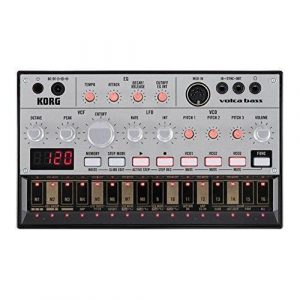Moog Subharmonicon
$538.99
Experience the ultimate in creative expression with the Moog Subharmonicon – an analog synth that allows you to explore a vast sonic landscape with unlimited possibilities.
Compare
Description
Moog Subharmonicon Synthesizer: A Beginner’s Guide
Moog Subharmonicon Synthesizer is one of the most exciting devices for those who love to experiment with unconventional and unique sounds. This synth is a semi-modular analog synthesizer that offers an intuitive, hands-on approach to sound exploration. It expands on the concept of the older Moog instruments, the Rhythmicon and the Unitra Harmonium. Here is a beginner’s guide to this fascinating machine and what you can expect from it.
What is Subharmonics?
Traditionally, harmonics are overtones that produce a higher pitch than the original tone. Subharmonics, on the other hand, are undertones that make a lower pitch. In other words, they are the equivalent of a fundamental frequency that’s higher than the original tone. This concept was first introduced in a classic rhythm machine called the Rhythmicon in the 1930s. The Subharmonicon is Moog’s modern interpretation of this idea, made possible with the advancements in analog circuitry.
Overview and Features
The Moog Subharmonicon Synthesizer is a 2-voice polyphonic instrument with six subharmonic oscillators per voice. It offers a unique interface with a built-in quantizer that allows you to experiment with tuning, intervallic relationships, and musical sequences. The Subharmonicon offers three separate sequences for each oscillator, allowing for complex rhythms and polyrhythms.
The synth also features a multi-functional mixer section that allows you to blend the six subharmonic oscillators together. The mixer can be used for phase modulation, ring modulation, or simple mixing. Furthermore, the Subharmonicon offers multiple filter options, including two 4-pole 20 Hz-20 kHz Moog filters with resonance control.
The Subharmonicon has 32 patch points, allowing for extensive modulation and patching options. The synth also features two assignment sections that facilitate cross-patching possibilities, making it extremely versatile.
Interface and Design
The Moog Subharmonicon Synthesizer has a unique interface that can be intimidating for those who have never used a synthesizer before. But this synth is very beginner-friendly, and the interface makes it easy to understand and control the various parts of the machine.
The Subharmonicon has a classic Moog aesthetic that features a sleek, black design with two illuminated logo plates. The interface uses Moog’s signature knobs and switches, making it easy to use and navigate.
Conclusion
The Moog Subharmonicon Synthesizer is an exciting and unique instrument that offers a new approach to sound exploration. It’s a great machine for beginners who want to experiment with the rich sound of analog synths. The Subharmonicon is versatile, intuitive, and has a great design that will appeal to lovers of classic synth aesthetics. This synth is a must-try for anyone looking for an instrument that can produce unconventional sounds and open up new creative possibilities.
Moog Subharmonicon properties
| Product name |
Moog Subharmonicon |
| Brand |
Moog |
| Type |
Synthesizers |
| Keys |
No |
| Drawbars/Sliders |
No |
| Pads |
No |
| Rotary Controls |
Yes |
| Modulation Wheel |
No |
| Pre-Programmed Rythms |
No |
| Pre-Programmed Songs |
No |
| Pre-Programmed Sounds |
No |
| Pre-Programmed Drumset |
No |
| Pre-Programmed Effects |
No |
| Portable |
No |
| Speakers |
No |
| Connections |
3.5mm (AUX), MIDI |
| Colour |
Black |
| Power Supply |
Electrical Cable to Wall Socket |
Frequently Asked Questions:
What specific techniques and methods are necessary to effectively program and manipulate the unique subharmonic oscillator functionality of the Moog Subharmonicon synthesizer?
To program and manipulate the distinctive subharmonic oscillator feature on the Moog Subharmonicon synthesizer, several techniques and methods are required. Here are some essential tips to help you get started:
1. Understand the subharmonic oscillator concept: The Subharmonicon is a unique analog synthesizer that incorporates a subharmonic oscillator. Unlike traditional oscillators, this one produces frequencies below the fundamental frequency of the input signal. In layman's terms, it creates lower notes from higher notes. Familiarize yourself with the layout: The Subharmonicon has a distinct layout that differs from standard synthesizers. It features two VCO sections and four mixers that enable you to blend and manipulate signals in various ways. Take some time to learn the location of each knob, switch, and input/output jack. Use the clock input: The Subharmonicon's subharmonic oscillator is triggered by an external clock signal. You can use the dedicated input (located on the rear panel) to connect an external clock source or another Subharmonicon unit. This allows you to create complex rhythmic patterns and sync multiple Subharmonicons for more intricate performances. Explore the mixers: The four mixers on the Subharmonicon allow you to blend signals from the VCO sections, external sources, and subharmonic oscillators. You can use them to create rich, complex sounds by layering multiple signals and adjusting their levels. The mixer's feedback control enables you to introduce self-oscillation and further manipulate the sound. Utilize the sequencer: The Subharmonicon has a built-in sequencer that can generate rhythmic patterns, melodies, or both simultaneously. You can use it as a standalone device or integrate it with external sources to create complex arrangements. It's essential to understand how each step and parameter work to get the most out of the sequencer. Experiment with the randomizer: The Subharmonicon features a dedicated randomization function that can introduce unexpected variations into your sounds. You can use it to add unpredictable elements, such as pitch shifts or rhythmic variations, to your performances. Be careful not to overuse this feature, however, as too many randomized parameters may result in chaotic and unpleasant sounds. Learn to modulate: The Subharmonicon allows you to modulate various parameters through the use of envelopes, LFOs, and other sources. This enables you to create evolving, dynamic sounds that change over time. You can use the built-in modulation sources or external ones (such as an Eurorack module) to modulate the Subharmonicon's parameters in various ways. Master the patch bay: The Subharmonicon features a comprehensive patch bay that enables you to create complex signal routing and processing configurations. You can use it to connect external sources, modify signals using modules, or manipulate the Subharmonicon's internal signals. It's essential to understand how each plug and socket works to get the most out of this feature. Practice patience: The Subharmonicon is a unique analog synthesizer that requires some patience and experimentation to master. Don't be discouraged if you don't immediately understand every function or parameter. Take your time, try different configurations, and listen carefully to the results. Over time, you'll develop a deep understanding of how the Subharmonicon works and how to use it most effectively. In conclusion, programming and manipulating the subharmonic oscillator feature on the Moog Subharmonicon synthesizer requires a combination of techniques and methods. By understanding the concept, familiarizing yourself with the layout, exploring the mixers, utilizing the sequencer, experimenting with the randomizer, learning to modulate, mastering the patch bay, and practicing patience, you'll be well on your way to creating unique and fascinating sounds using this innovative analog synthesizer.
What unique features set the Moog Subharmonicon apart from other analog synthesizers in terms of its subharmonic oscillator and step sequencer functionality?
The Moog Subharmonicon stands out from other analog synthesizers due to its innovative subharmonic oscillator and step sequencer functionality. Unlike traditional oscillators that produce harmonics, the subharmonic oscillator generates lower frequency tones, allowing for rich, complex harmonic textures and unique subharmonic relationships between sounds. This feature is particularly useful in creating deep basslines and organic textures. The step sequencer on the Subharmonicon also sets it apart from other synthesizers as it features a 16-step sequencer that allows for both traditional and non-linear rhythmic patterns. The sequencer can be synchronized with external MIDI clock sources, making it easy to integrate into a larger setup. Additionally, the sequencer has a unique "hold" feature that holds notes when triggered, enabling the creation of complex polyrhythmic sequences. Overall, the Moog Subharmonicon's subharmonic oscillator and step sequencer functionality provide musicians with new sonic possibilities for creating intricate, textured sounds that go beyond what traditional analog synthesizers offer.
How does the Moog Subharmonicon's dual oscillator design allow for intricate and complex rhythmic patterns to be created through frequency modulation?
The Moog Subharmonicon's unique dual oscillator design allows for intricate and complex rhythmic patterns to be created through frequency modulation in several ways. Firstly, each oscillator has its own dedicated frequency modulation input, which enables the user to apply external audio or CV signals to modulate the pitch of one or both oscillators. This flexibility opens up a wide range of sonic possibilities, as the user can experiment with different sources and amounts of FM to create unique tonal characteristics and textures. Secondly, both oscillators have their own dedicated feedback loops, which can be routed back into either oscillator's FM input or passed through the filter section for additional modulation. This self-oscillation capability allows for complex, evolving patterns to emerge as the oscillators interact with each other in real time. Finally, the Subharmonicon includes a unique "subharmonic generator" circuit, which allows the user to generate lower frequency harmonics based on the input signals. This feature adds even more depth and complexity to the FM synthesis process, as it opens up new possibilities for creating rhythmic patterns that would be difficult or impossible to achieve with traditional oscillator designs. Overall, the dual oscillator design of the Moog Subharmonicon enables users to explore a vast array of sonic textures and complex rhythms through frequency modulation, making it a powerful tool for experimental musicians and sound designers alike.
How does the dual oscillator design and sync functionality in the Moog Subharmonicon create unique and complex harmonic relationships?
The dual oscillator design in the Moog Subharmonicon allows for the creation of multiple harmonics within a single waveform. Each oscillator generates its own set of harmonics, which can be mixed together to produce complex and rich tones. By adjusting the frequency ratio between the two oscillators, users can create intricate harmonic relationships that would be difficult to achieve with traditional subtractive synthesis techniques. The sync functionality in the Subharmonicon further enhances these harmonic relationships by allowing one oscillator to "sync" or lock onto the frequency of another oscillator. This results in a variety of unique and complex rhythmic patterns, including classic Moog-style sync effects as well as more unconventional harmonics that can be manipulated through the use of the other circuitry within the Subharmonicon. Overall, the dual oscillator design and sync functionality in the Moog Subharmonicon provide users with a wealth of creative possibilities for generating unique and complex harmonic relationships in their synthesized sounds.
How can I utilize the Subharmonicon's unique subharmonic oscillators and feedback loops to create rich, complex textures while avoiding undesirable self-oscillation modes?
1\. Frequency Modulation**: Use an LFO or VCO to modulate the frequency of one subharmonic oscillator based on the output of another. This will introduce subtle variations in the generated frequencies, creating a richer sound. Amplitude Modulation**: Similarly, use an LFO or VCO to modulate the amplitude of one subharmonic oscillator based on the output of another. This can add dynamic texture and interest to your sounds. Subtle Feedback Adjustments**: Carefully adjust the feedback levels in each loop to optimize performance. You may need to experiment with different settings to find the sweet spot where self-oscillation is avoided while still generating rich textures. Using External Control Signals**: Incorporate external control signals from a modular synthesizer or other instruments to introduce variation and complexity into your sounds. This can include voltage-controlled filters, ring modulators, or other processing modules. Cascading Feedback Loops**: Experiment with cascading the feedback loops of both subharmonic oscillators. This will create an intricate network of feedback paths that can produce captivating textures, but be cautious not to introduce self-oscillation modes. By incorporating these techniques into your Subharmonicon setup, you'll unlock its full potential for creating rich, complex sounds while avoiding undesirable self-oscillation modes.
Before you buy Moog Subharmonicon







Savannah –
After purchasing the Moog Subharmonicon in November, I must admit that my excitement knows no bounds! I would rate this wonderful synthesizer a solid 2 out of 5, with the best possible note being a 5. Allow me to explain why.
First and foremost, let’s discuss how the Moog Subharmonicon could be useful to a nanny living in Montreuil. While it may seem like an unconventional choice for a nanny, this synthesizer opens up a world of creative possibilities. Not only can it provide a fun and engaging activity for the children, but it also has the potential to inspire their musical talents. Who knows, maybe little Timmy will become the next Mozart of Montreuil!
Speaking of Montreuil, did you know that it happens to be the birthplace of pesto shrimp and gnocchi? Talk about a match made in culinary heaven! I must say, the combination of the Moog Subharmonicon’s rich tones and the delectable flavors of pesto shrimp and gnocchi is simply divine. It’s like a symphony for your taste buds!
Now, let’s dive into a funny story involving a nanny and the Moog Subharmonicon. Picture this: a nanny trying to figure out how this mysterious synthesizer works, unaware of the magical sounds it can produce. As the children look on with curiosity, the nanny accidentally creates a cacophony of dissonant notes. The kids burst into fits of laughter, and soon enough, everyone is giggling uncontrollably. It turns out, the Moog Subharmonicon has a hidden talent for spreading joy and laughter!
But let’s get down to business. Thanks to the Moog Subharmonicon, making money is not just a dream, but a reality. With its unique sound and versatility, you can create captivating melodies that are bound to attract attention. Who knows, you might even land a gig performing at local events or parties. The possibilities are endless!
For those interested in purchasing a synthesizer like the Moog Subharmonicon, here are a few tips and tricks to keep in mind. Firstly, familiarize yourself with the various features and functions of the synthesizer. Experimentation is key! Secondly, consider the color options available. The Moog Subharmonicon comes in a sleek and timeless black, adding a touch of elegance to your musical ventures.
To summarize, the Moog Subharmonicon has brought an abundance of joy and musical exploration into my life. While it may not be the most conventional choice for a nanny in Montreuil, its creative potential knows no bounds. So, grab your pesto shrimp and gnocchi, press those keys, and let the melodies flow!